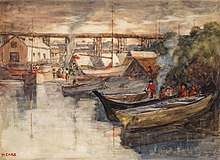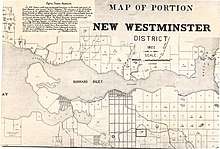Senakw
Sen̓áḵw (Squamish Salish pronunciation: [sen̰aqʷ]) or sən̓aʔqʷ (Halkomelem Salish pronunciation: [sənˀaʔqʷ]), rendered in English as Snawk, Snawq, Sneawq, or Snawkw, is a village site of the Indigenous Squamish people, located near what is now known as the Kitsilano neighbourhood of Vancouver, British Columbia, Canada. In 1869 the Colonial Government set aside land around the village, and in 1877 the Joint Reserve Commission established by the Provincial and Federal Governments to deal with land allotments to indigenous people in B.C., expanded the area set aside to approximately 80 acres (32 ha) as False Creek Indian Reserve No. 6 or more popularly Kitsilano Indian Reserve. The village site was home for many Squamish, but after further settlement began in the Vancouver area, the inhabitants were forced to relocate to other nearby villages. This village was also the home of August Jack Khatsahlano, a prominent chief (or siyam) of the Squamish and a notable Vancouver historian on local Indigenous history.

History

After the Indian Act was passed in 1876, and with the Joint Indian Reserve Commission, a reserve was plotted out for the native peoples living at this location.[1] Both in 1886 and 1902, portions of the reserve were expropriated by the federal government for railway purposes. In 1913 the B.C. Provincial Government induced the residents to relocate by coercing them to sell, an action which was later found to be illegal. Many families were placed on a barge and towed to other communities in the Burrard Inlet area.[2] In 2001, a settlement was agreed between the courts and the Squamish Nation for the return of 11.7 acres (4.7 ha) of land, coming from the land possessed by the CPR, located near Vanier Park, underneath Burrard Street Bridge.[3][4]
In 2019, the Squamish Nation announced plans to build a housing development on this land. Initially planned for 3,000 units,[5] it was later increased to 6,000 units.[6][7]
See also
- Squamish history
- List of Squamish villages
References
- Hogben, David (August 29, 2002) The Vancouver Sun, Kitsilano land belongs to natives, appeal judges agree Archived February 14, 2010, at the Wayback Machine p.A2
- Sterrit, Angela. "The little-known history of Squamish Nation land in Vancouver". CBC News. Retrieved May 2, 2019.
- Lancaster, Deanna (September 1, 2002), The North Shore News, Natives accepting 92.5 million from Feds Archived February 14, 2010, at the Wayback Machine p.10
- SOC Mathias et al.
- "Squamish Nation plans large housing development at south end of Burrard Bridge". CBC News. Retrieved May 2, 2019.
- "Vancouver mayor calls massive First Nation development a 'gift to the city'". Canadian Broadcasting Corporation. November 7, 2019. Retrieved November 8, 2019.
- "Squamish Nation planning 6,000 new homes next to Burrard Bridge (RENDERINGS) | Urbanized". dailyhive.com.